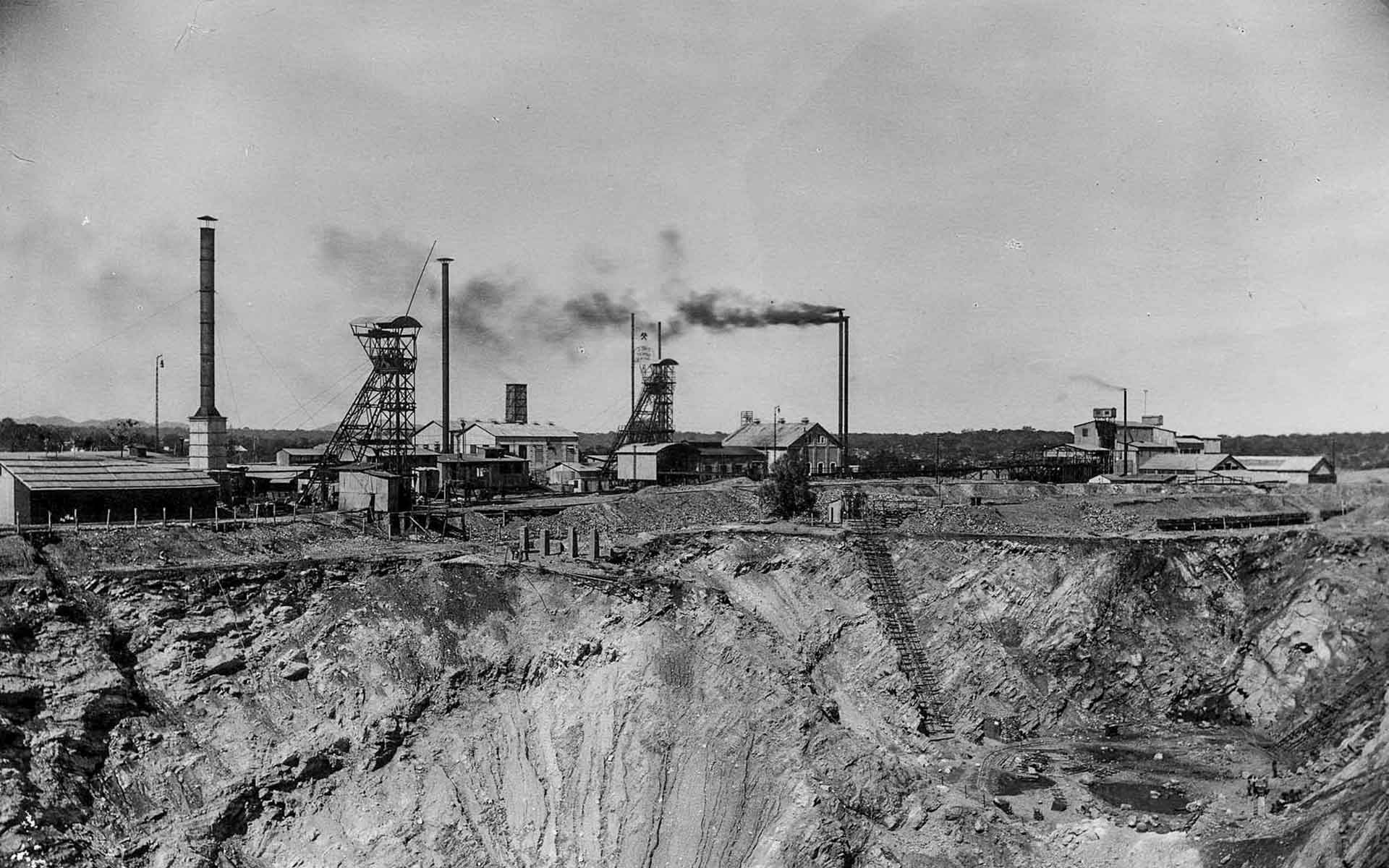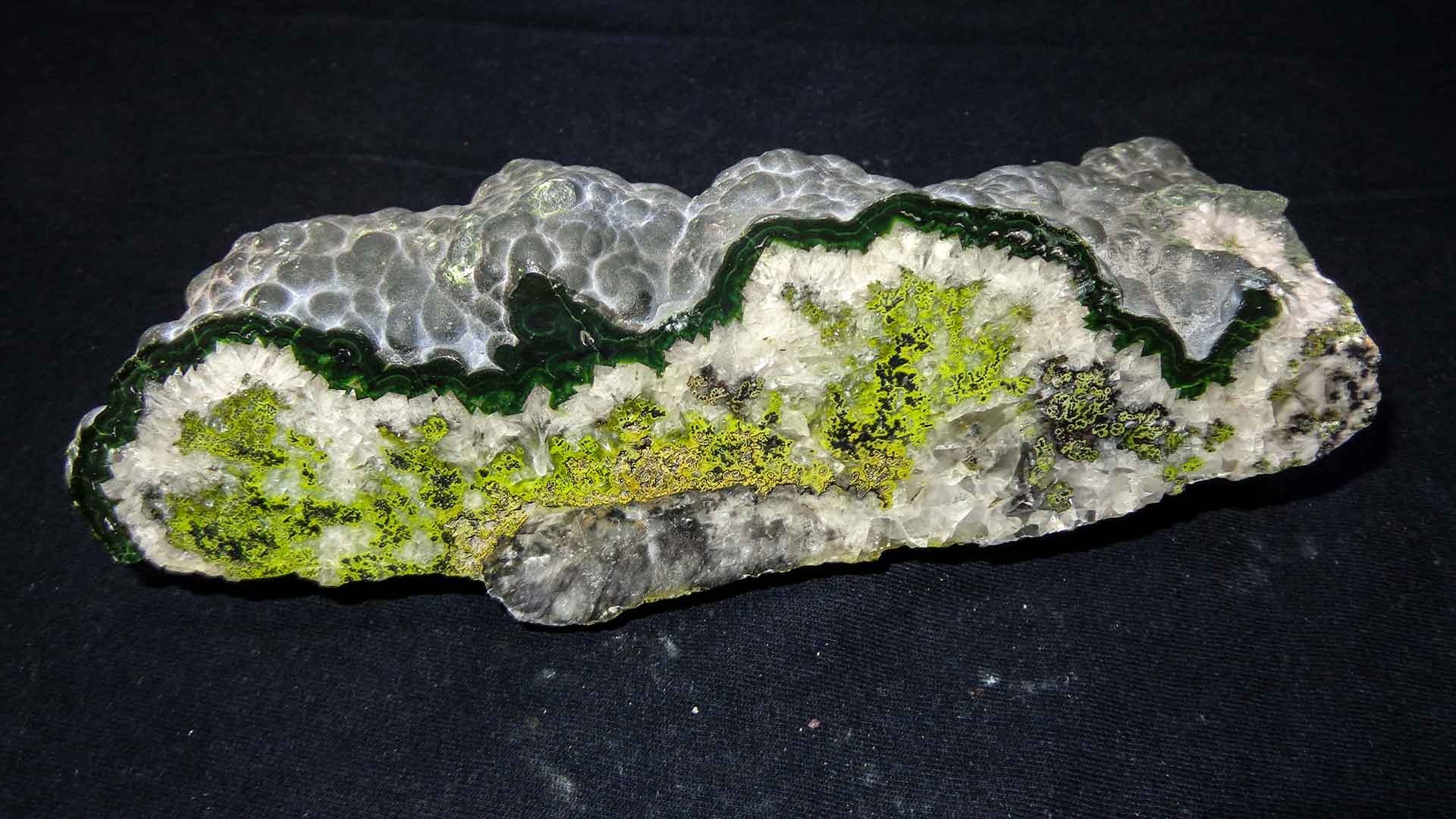
Tsumeb Mine 1936. From left to right: Old Shaft No.1 Headframe, Steigerhaus, New Shaft No. 1 Headframe, Powerplant Hall and Ore processing.
Geological Period
Palaeozoic Era, Early Cambrian Period
Main geological interest
Mineralogy
History of geosciences
Location
Otjikoto Region, Namibia.
19°13’00.0″S, 17°42’00.0″E
Tsumeb Mine 1936. From left to right: Old Shaft No.1 Headframe, Steigerhaus, New Shaft No. 1 Headframe, Powerplant Hall and Ore processing.
One of the richest ore deposits with respect to variety, rarity and aesthetics of minerals in the world.
The Tsumeb polymetallic (Copper-Lead-Arsenic-Zinc-Silver-Germanium-Molybdenum) deposit contains one of the most diverse examples of mineralogical paragenesis observed within a single mineral deposit (Keller, 1977). The unique hydrothermal processes provided oxidizing waters to lower parts of the deposit causing the formation of a variety of minerals with increasing depth of the ore body. This provided special conditions for the development of secondary minerals of extreme beauty with respect to form and habit (Bowell and Mocke, 2018). In addition, the detection and occurrence of extremely rare elements in the deposit like Germanium and Gallium led to the development of extremely rare minerals.
- Geological description
The Tsumeb ore deposit lies in the upper part of the Neoproterozoic Otavi Group that comprises limestone and dolomite. This polymetallic Tsumeb-type deposit has an age of 530 ± 11 Ma (Kamona and Günzel, 2007) and takes on the structure of a pipe that is infilled by feldspar-rich sandstone and sandstone breccia of the overlying Mulden Group, which have undergone various degrees of hydrothermal alteration fueled by karstification processes (Lombaard et al., 1986). The pipe has approximate dimensions of 120 by 15 m in cross section. It is steeply dipping and extends from the surface to a depth of approximately 1 700 m. It hosts a polymetallic (Copper-Lead-Arsenic-Zinc-Silver-Germanium-Molybdenum) deposit with three oxidation zones, which contain a great diversity of ore minerals of lead, copper, zinc, silver, arsenic, antimony, cadmium, cobalt, germanium, gallium, gold, iron, mercury, molybdenum, nickel, tin, vanadium and tungsten. Three vertical zones of oxidation in the mineralised pipe structure enabled the development of extensive assemblages of secondary mineral species such as tsumebite, arsentsumebite, schneiderhöhnite, ludlockite and leiteite. The deposit hosts approximately 489 minerals of which 72 minerals were first described from the deposit and more than 25 minerals are known only from the Tsumeb ore deposit.
- Scientific research and tradition
In 1906 Otto Schneider of the Berlin Mining Academy detected the mineral Otavite. Hans Schneiderhöhn of the University of Freiburg investigated the ore minerals. Hugo Strunz from the Berlin Institute of Technology, Bruno Geier and Gerhard Söhnge from Tsumeb Corporation Limited described the rare minerals stottite and söhngeite.
Longitudinal and cross sections through the Tsumeb ore pipe after Lombaard et al. 1986 and from the original sketch by P. G. Soehnge in the 1960s, used with permission from the Geological Survey of Namibia. The red indicates massive ore, yellow is feldspathic sandstone, light blue is dark dolomite breccia, aqua represents calcitized dolomite, white is silica dolomite, light purple is calcitized breccia and pink is a calcite plug.
- Reference
Bowell, R. and Mocke, H. (2019) ‘Minerals New to Tsumeb’, Communications – Geological Survey of Namibia, 19, pp. 20–46.
Kamona, A.F. and Günzel, A. (2007) ‘Stratigraphy and base metal mineralization in the Otavi Mountain Land, Northern Namibia—a review and regional interpretation’, Gondwana Research, 11(3), pp. 396–413. Available at: https://doi.org/10.1016/j.gr.2006.04.014.
Keller, P. (1977) ‘Paragenesis’, in W.E. Wilson (ed.) Mineralogical Record. (TSUMEB! (NAMIBIA) SPECIAL ISSUE, 8 (3)), pp. 38–47.
Keller, P. and Innes, J. (1986) ‘Neue Mineralfunde aus Tsumeb’, Lapis, pp. 28–32.
Lombaard, A.F. et al. (1986) ‘The Tsumeb lead-copper-zinc-silver deposit, South West Africa/Namibia, 1761-1787’, in Mineral deposits of Southern Africa. Anhaeusser, C.R. and Maske, S. (Eds). Johannesburg: Geological Society of South Africa (2), pp. 1021–2335.
- Author(s)
Helke Mocke
Geological Survey of Namibia, Namibia
Thomas Böllinghaus
Federal Institute for Materials, Research and Testing, Germany
Rob Bowell
Queen’s University, Canada
Gabi Schneider
Namibia Uranium Institute, Namibia


